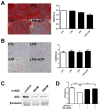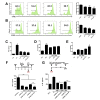The activation of NLRP3 inflammasome potentiates the immunomodulatory abilities of mesenchymal stem cells in a murine colitis model
- PMID: 32475381
- PMCID: PMC7330809
- DOI: 10.5483/BMBRep.2020.53.6.065
The activation of NLRP3 inflammasome potentiates the immunomodulatory abilities of mesenchymal stem cells in a murine colitis model
Abstract
Inflammasomes are cytosolic, multiprotein complexes that act at the frontline of the immune responses by recognizing pathogen- or danger-associated molecular patterns or abnormal host molecules. Mesenchymal stem cells (MSCs) have been reported to possess multipotency to differentiate into various cell types and immunoregulatory effects. In this study, we investigated the expression and functional regulation of NLR Family Pyrin Domain Containing 3 (NLRP3) inflammasome in human umbilical cord blood-derived MSCs (hUCB-MSCs). hUCB-MSCs expressed inflammasome components that are necessary for its complex assembly. Interestingly, NLRP3 inflammasome activation suppressed the differentiation of hUCB-MSCs into osteoblasts, which was restored when the expression of adaptor proteins for inflammasome assembly was inhibited. Moreover, the suppressive effects of MSCs on T cell responses and the macrophage activation were augmented in response to NLRP3 activation. In vivo studies using colitic mice revealed that the protective abilities of hUCB-MSCs increased after NLRP3 stimulation. In conclusion, our findings suggest that the NLRP3 inflammasome components are expressed in hUCB-MSCs and its activation can regulate the differentiation capability and the immunomodulatory effects of hUCB-MSCs. [BMB Reports 2020; 53(6): 329-334].
Conflict of interest statement
The authors have no conflicting interests.
Figures





